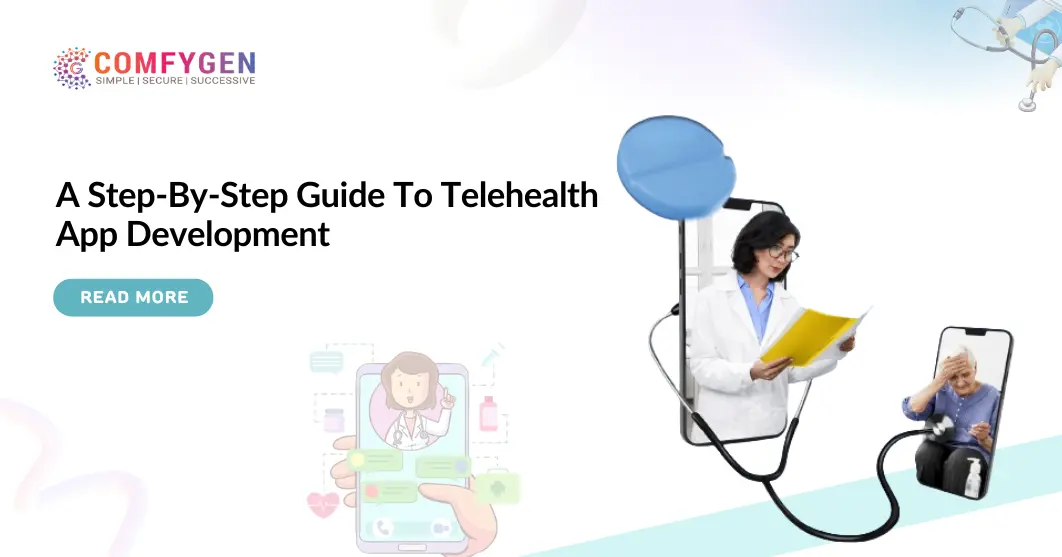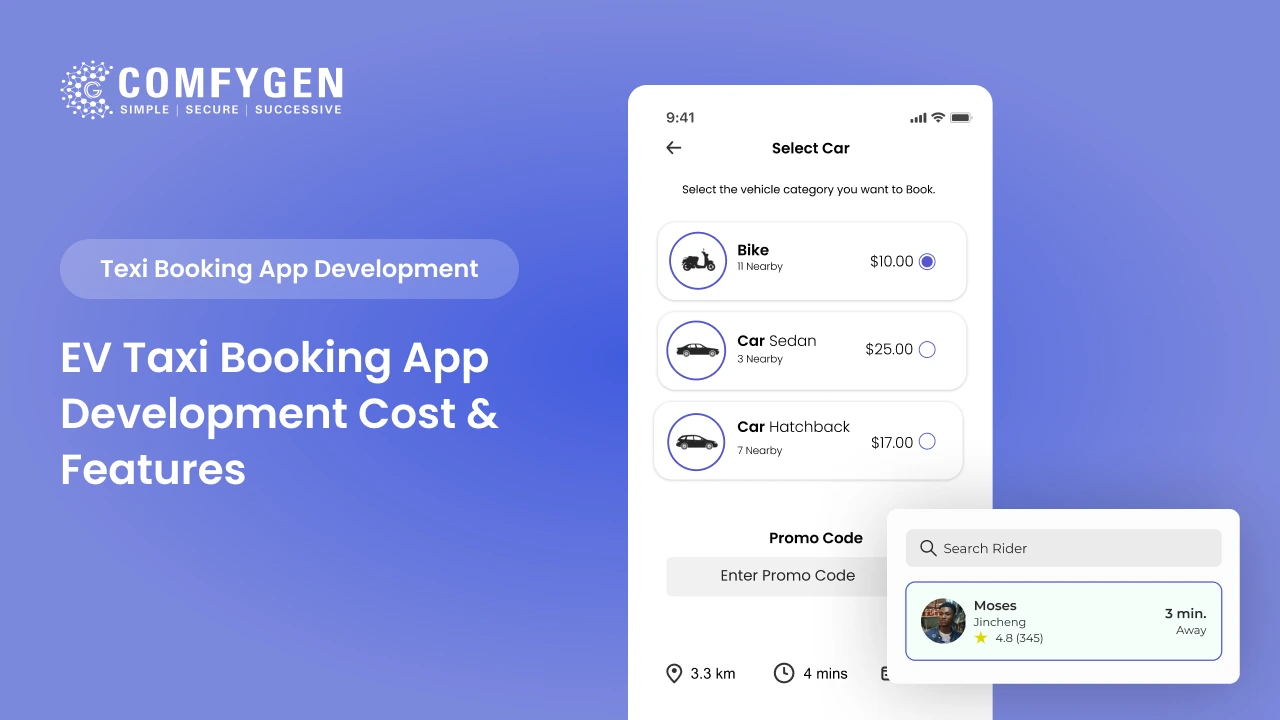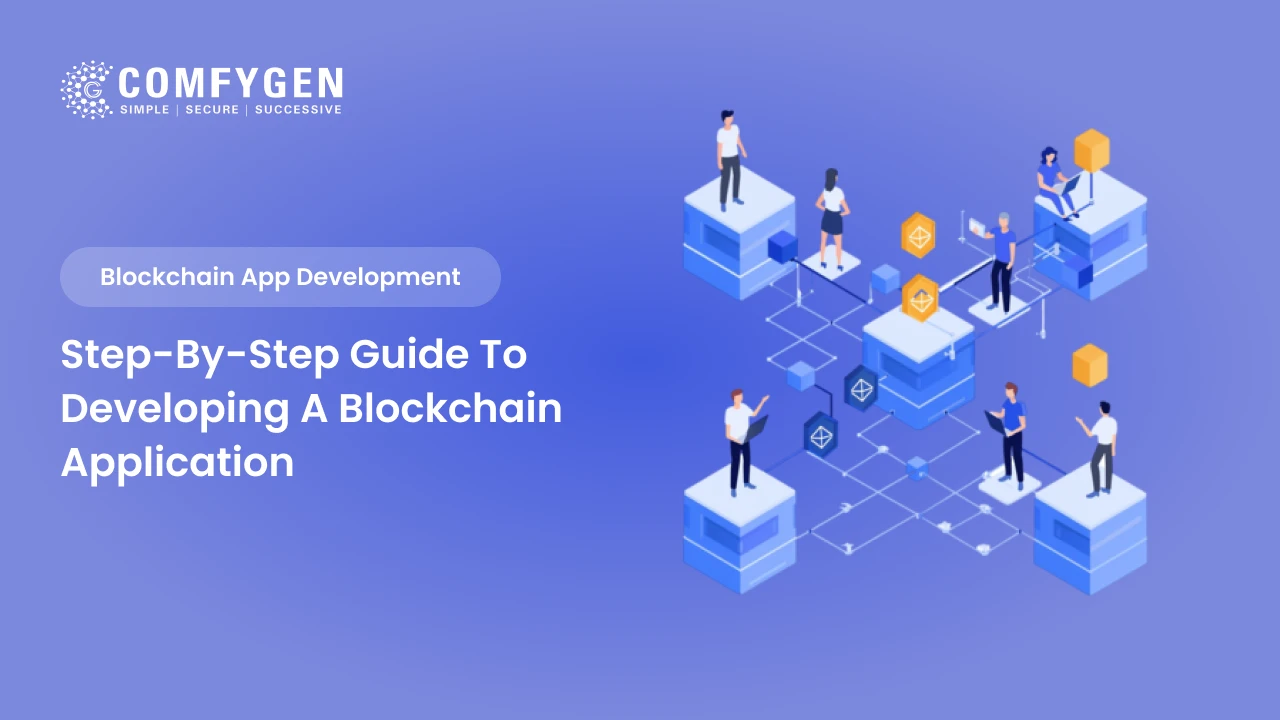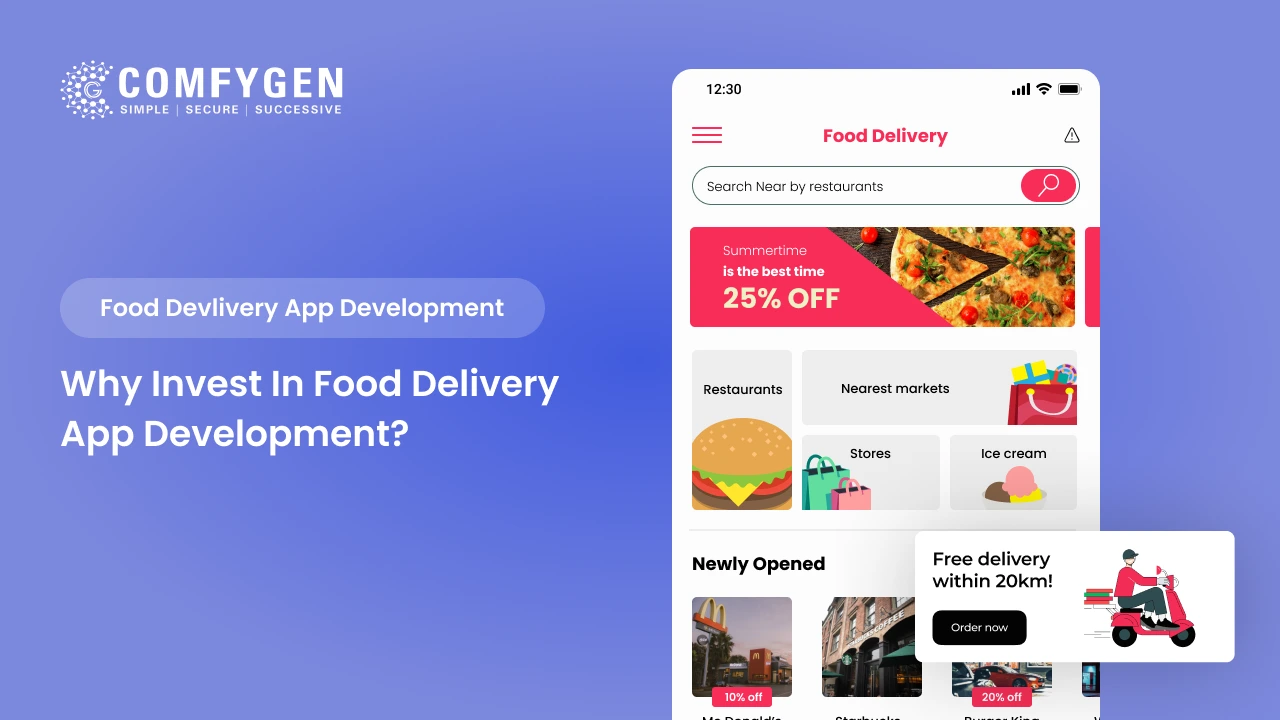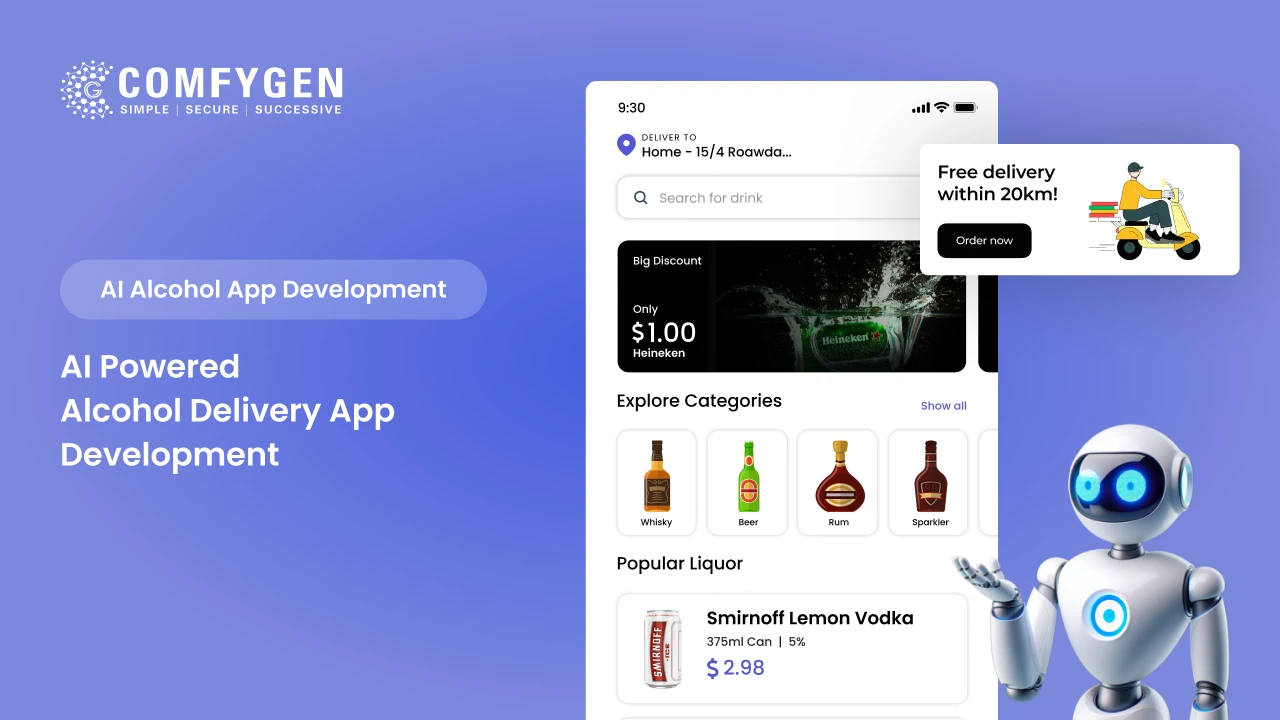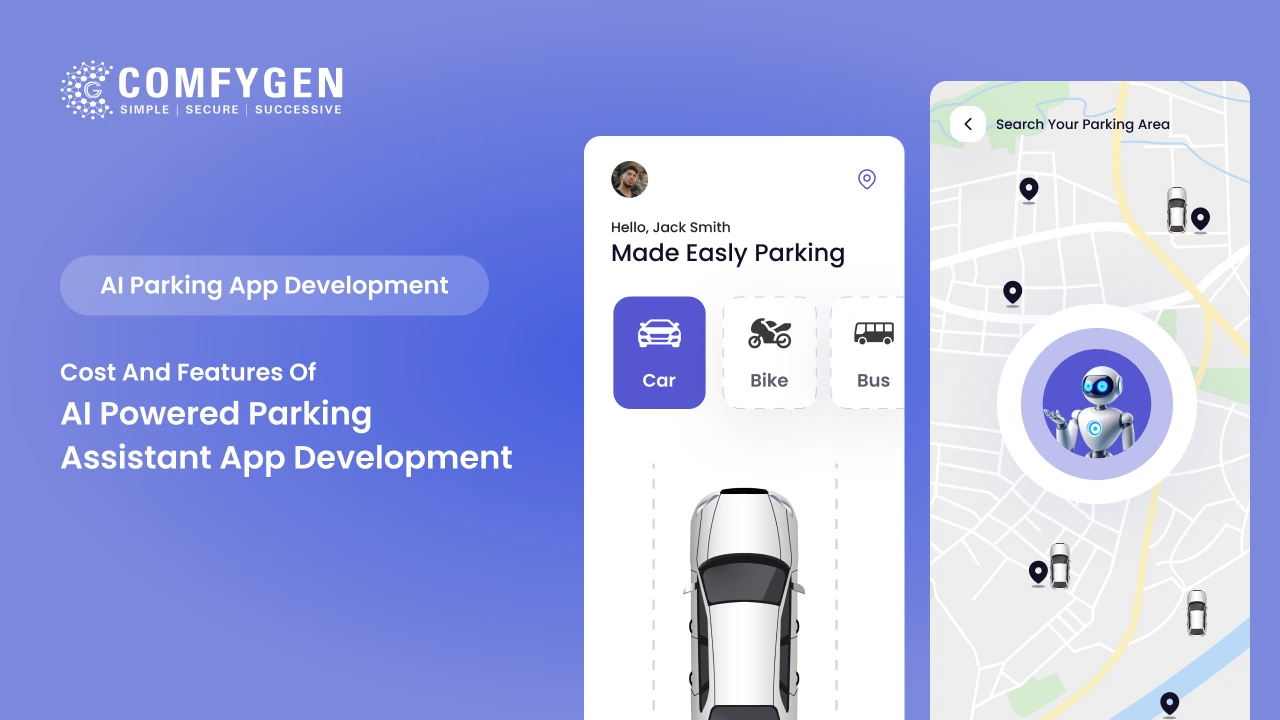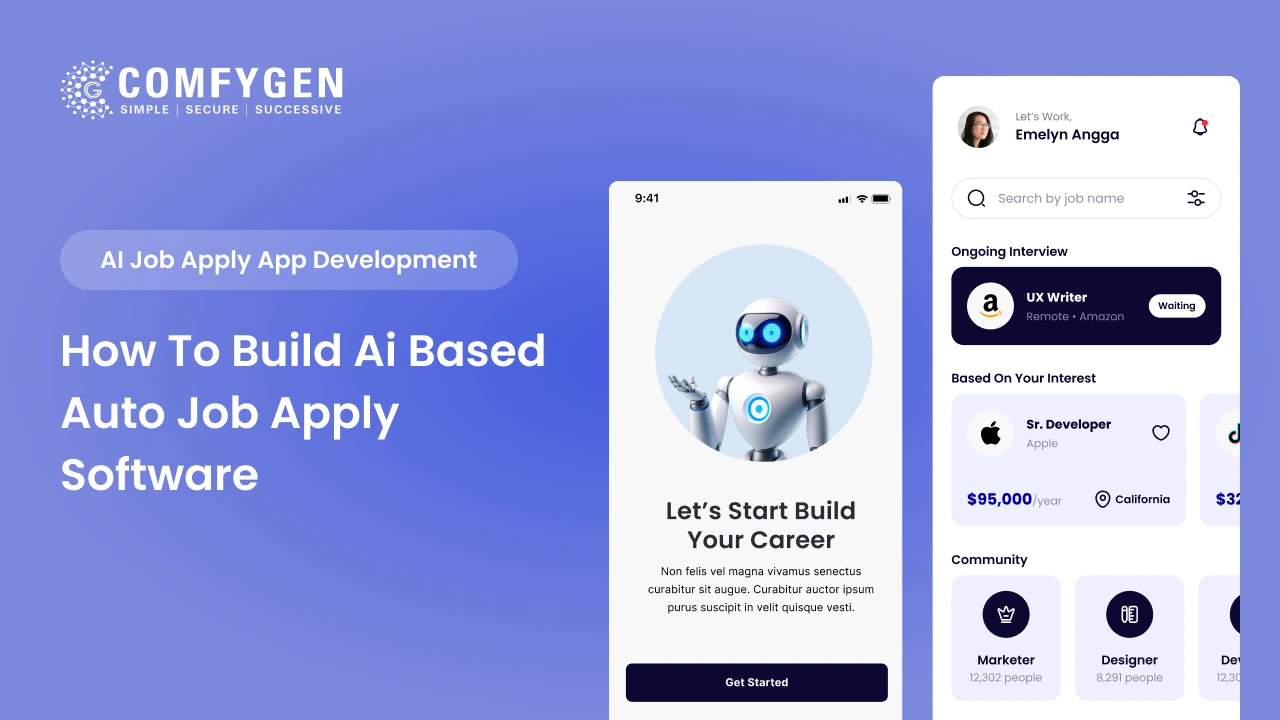A Step-By-Step Guide To Telehealth App Development
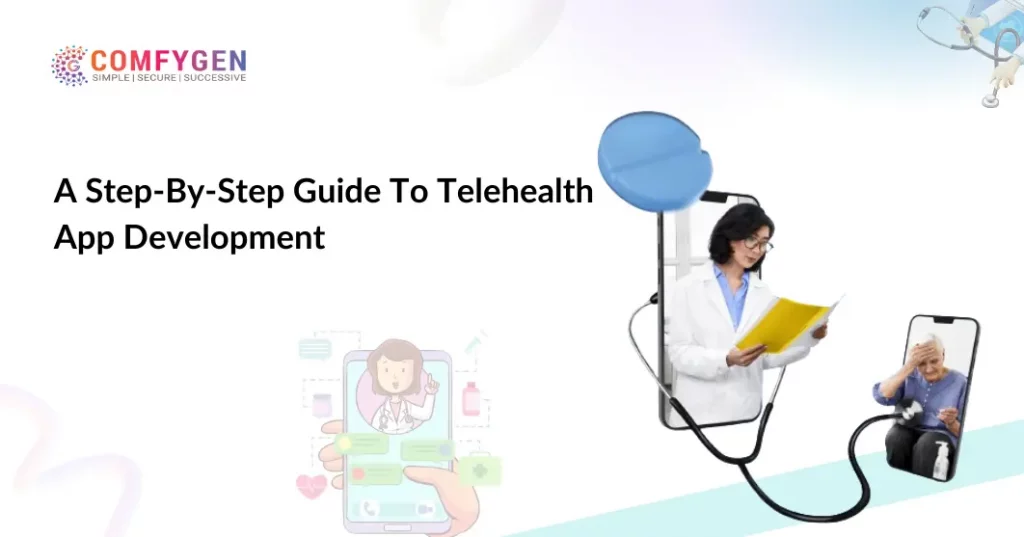
Telehealth apps have helped the healthcare professionals and patients lots in their treatments and management processes. Having telehealth applications in healthcare benefitted the industry in several ways. The telehealth and telemedicine market was anticipated to grow at US$120.4 Billion in 2023, which is projected to reach at US$285.7 Billion by 2028 with a CAGR of 23.2%.
The demand is surging and it will continue increasing gradually. Be it small and big healthcare industry are also seeking some robust and secure telehealth application development for their system. Well, we decided to create this blog explaining everything possible about the “Telehealth App Development Guide.”
It is suggested to read the demonstrations and consider them if planning to build a custom telehealth app. The guide will help you be aware of several things before a development project is handed over to healthcare app developers.
What Are Telehealth Apps?
Telehealth apps are digital platforms that allow patients and healthcare providers to connect remotely. Using these mobile telehealth apps, patients can consult with doctors, receive medical advice, and access health services without needing to visit a clinic or hospital. These apps often include features like video calls, messaging, appointment scheduling, and access to medical records. Telehealth applications are designed to make healthcare more accessible and convenient, especially for those in remote areas or with mobility issues. They can also save time and reduce the need for in-person visits. By using telehealth apps, patients can get timely care, monitor chronic conditions, and maintain regular check-ups from the comfort of their homes.
Also Read: The Comprehensive Guide To Telemedicine App Development
Importance Of Telehealth Apps In Modern Healthcare
The telehealth apps can revolutionize the healthcare industry, and potent to give it a futuristic approach. It improves the efficiency, accessibility, and adds more convenience to healthcare professionals & patients all. However, these telehealth app solutions show its true significance during the major chronic diseases; which requires regular monitoring.
To understand the significance of telehealth in modern healthcare with more clarity, let’s acknowledge the reasons to use it. The benefitted reasons are enough to explain the value of apps in the industry:
- Increased Accessibility
Telehealth apps make it easier for people in rural or remote areas to get medical care. Instead of traveling long distances to see a doctor, patients can consult with healthcare providers from the comfort of their homes. This is especially helpful for those who have mobility issues or live far from medical facilities.
- Convenience and Time-Saving
With telehealth apps, you can schedule appointments, consult with your doctor, and even get prescriptions without leaving your house. This saves time that would otherwise be spent in waiting rooms or traveling to and from the clinic. Plus, it’s super convenient for busy individuals who struggle to fit doctor visits into their hectic schedules.
- Cost-Effective
Telehealth can reduce healthcare costs by cutting down on unnecessary in-person visits and hospital admissions. It’s more affordable for patients, too, as they save on travel expenses and can often find lower consultation fees compared to traditional visits. This makes healthcare more accessible to everyone.
- Improved Patient Engagement
Telehealth apps often come with features that keep patients more engaged in their healthcare. You can easily access your medical records, get reminders for appointments and medications, and have direct communication with your healthcare provider. This encourages better adherence to treatment plans and proactive management of your health.
- Enhanced Care Quality
By enabling continuous monitoring and quick consultations, telehealth apps help in early detection and timely treatment of medical issues. Patients with chronic conditions can be regularly monitored, reducing complications and improving overall health outcomes. This leads to a higher quality of care and better health management.
Ready to Build Your Own Telehealth App?
Types Of Telehealth Applications
So here listed the best types of Telehealth Applications:
- Real-time Interaction
This is like having a face-to-face chat with your doctor, but through your phone or computer. Real-time interaction allows for video calls, voice calls, or live chats where you can discuss your symptoms, get a diagnosis, and receive immediate advice. It’s super convenient because you get instant feedback and can see your doctor without leaving your house.
- Remote Monitoring
Imagine having your health monitored regularly without having to visit the clinic. Remote monitoring uses devices like wearables or home health equipment to keep track of your vital signs, such as heart rate, blood pressure, or glucose levels. The data is sent to your healthcare provider, who can monitor your health trends and catch any issues early. This is great for managing chronic conditions.
- Store-and-Forward
Store-and-forward is all about sharing medical information without needing both parties to be present at the same time. You can send your medical records, images, or test results to a specialist, who will review them later and get back to you with their findings. It’s like emailing your doctor all your info and waiting for their response. This is particularly useful for getting second opinions or specialist consultations.
Read More: Healthcare Application Development | Benefits, Process, Features and Cost
Must Have Features for Telehealth Apps
Consider the features listed to implement in your telehealth apps to make it more interesting and engaging:
- Video Conferencing:
Enables real-time video consultations with healthcare providers, allowing patients to receive immediate care and advice without needing to visit a clinic.
- Appointment Scheduling:
Lets patients easily book, reschedule, or cancel doctor appointments online, offering convenience and reducing administrative hassles for both patients and healthcare providers.
- Secure Messaging:
Provides a safe and private way for patients and doctors to communicate, share updates, and discuss health concerns without compromising confidentiality.
- E-Prescriptions:
Allows doctors to prescribe medications electronically, making it easy for patients to get their prescriptions filled at their preferred pharmacy.
- Payment Integration:
Facilitates seamless payment processing within the app, allowing patients to pay for consultations and services securely and conveniently.
Also Read: Top Trends In Healthcare App Development For 2024
Advanced Technologies Used for Telehealth App Development
It is beneficial to implement some latest technology trends during telehealth app development. These trending tech-enabled benefits will help engaging the end-users more:
- AI and Machine Learning
Artificial Intelligence and Machine Learning enhance telehealth apps by providing predictive analytics, personalized treatment recommendations, and automated patient triage. These technologies can analyze patient data to identify patterns and trends, improving diagnosis accuracy and patient outcomes.
- Remote Monitoring
Leveraging advanced sensors and wearable devices, remote monitoring continuously tracks patients’ vital signs and health metrics. This real-time data is sent to healthcare providers, enabling early detection of potential issues and timely interventions, especially for chronic disease management.
- Data Analytics
Data analytics processes vast amounts of health data to uncover valuable insights. It helps healthcare providers make informed decisions, identify trends, and improve patient care. By analyzing data, telehealth apps can offer personalized healthcare plans and enhance overall efficiency.
- Integration with Electronic Health Records (EHRs)
Integrating telehealth apps with EHRs ensures seamless access to comprehensive patient medical histories. This integration allows healthcare providers to make more informed decisions, streamline workflows, and maintain continuity of care across different healthcare settings.
- Blockchain Technology
Blockchain enhances data security and privacy in telehealth apps by providing a decentralized and tamper-proof system for storing patient information. It ensures that medical records are secure, transparent, and only accessible to authorized users, reducing the risk of data breaches.
- Internet of Things (IoT)
IoT connects various medical devices and sensors to telehealth apps, enabling real-time monitoring and data collection. This connectivity allows for continuous health tracking, automatic alerts for abnormal readings, and improved patient engagement in managing their health.
Want To integrate EHR Into Your Telemedicine Application
Benefits Of Telehealth App Development
The benefits of Telehealth App Development is for both parties; healthcare professionals as well as patients. Read and know the benefits to attain by these efficient apps:
Benefits for Healthcare Professionals or Doctors
- Increased Efficiency
Telehealth apps streamline administrative tasks like scheduling and record-keeping, allowing healthcare providers to focus more on patient care.
- Expanded Reach
Doctors can consult with patients from remote or underserved areas, broadening their patient base and improving access to care.
- Better Patient Management
Continuous monitoring and easy access to patient data help healthcare professionals manage chronic conditions more effectively, ensuring timely interventions.
- Reduced No-Shows
Virtual appointments reduce the likelihood of missed appointments, improving clinic schedules and patient adherence to treatment plans.
- Enhanced Collaboration
Telehealth apps facilitate better communication and collaboration among healthcare teams, ensuring coordinated and comprehensive patient care.
Benefits for Patients
- Convenience
Patients can consult with healthcare providers from the comfort of their homes, saving time and reducing the need for travel.
- Access to Specialists
Telehealth apps make it easier for patients to get consultations from specialists, regardless of their location, leading to better health outcomes.
- Cost Savings
Virtual consultations often cost less than in-person visits, and patients save on travel and associated expenses.
- Continuous Care
Patients with chronic conditions can benefit from regular remote monitoring, ensuring their health is consistently managed and monitored.
- Enhanced Engagement
With easy access to their health records, appointment reminders, and direct communication with healthcare providers, patients are more engaged in their healthcare journey.
Also Read: How Much Does It Cost To Develop A Healthcare Application?
Regulatory Compliance And Security
When you develop healthcare app solutions, it is mandated to integrate regulatory compliances and security. These compliances make your applications friendly to governance:
- Understanding Healthcare Regulations (HIPAA, GDPR)
Healthcare regulations like HIPAA (Health Insurance Portability and Accountability Act) in the U.S. and GDPR (General Data Protection Regulation) in the EU are crucial. They ensure patient data is protected, privacy is maintained, and data breaches are prevented. Telehealth apps must comply with these regulations to avoid legal issues and ensure patient trust.
- Ensuring Data Security and Privacy
Data security involves protecting patient information from unauthorized access, breaches, and cyber threats. Telehealth apps must use encryption, secure authentication, and regular security audits to safeguard data. Ensuring privacy means maintaining confidentiality and handling patient data responsibly, adhering to legal standards.
- Compliance with Telehealth Standards
Telehealth standards involve guidelines for safe and effective virtual healthcare delivery. These standards include secure communication, accurate patient identification, and proper documentation. Compliance ensures that telehealth services are reliable, meet quality benchmarks, and provide consistent care across different platforms and providers.
Want to Develop Best Telehealth Mobile Application?
Telehealth App Development Process
Know the process of telehealth app development before you hand over the project. It would be better to know the process first, so that you will be aware of every ongoing stage during app development:
- Market Research and Planning
Start by conducting thorough market research to understand the needs and preferences of your target audience. Identify key features and functionalities that will make your app competitive. Create a detailed project plan outlining the development timeline, budget, and resources required.
- Define Requirements
Collaborate with healthcare professionals to define the app’s technical and functional requirements. This includes specifying user roles, security protocols, and compliance with healthcare regulations. Ensure the app addresses both patient and provider needs effectively.
- Choose the Right Technology Stack
Select the appropriate technology stack for your telehealth app. This includes choosing the programming languages, frameworks, and tools that will ensure the app is robust, scalable, and secure. Consider future maintenance and updates when making these choices.
- Design the User Interface (UI)
Create an intuitive and user-friendly UI that caters to both patients and healthcare providers. Focus on ease of navigation, accessibility, and a seamless user experience. Use wireframes and prototypes to visualize the app’s design and gather feedback before development.
- Develop and Test the App
Begin the development process by coding the app’s features and functionalities. Conduct rigorous testing throughout the development cycle to identify and fix bugs. Perform usability testing to ensure the app is easy to use and meets user expectations.
- Ensure Security and Compliance
Implement strong security measures to protect patient data, including encryption, secure authentication, and regular security audits. Ensure the app complies with healthcare regulations such as HIPAA and GDPR, as well as telehealth standards.
- Launch and Monitor
Deploy the app to app stores and other distribution platforms. Monitor its performance using analytics tools to track user engagement, identify issues, and gather feedback. Use this data to make continuous improvements and updates to enhance the app’s functionality and user experience.
- Provide Support and Maintenance
Offer ongoing support and maintenance to address any technical issues and ensure the app runs smoothly. Regularly update the app with new features, security patches, and improvements based on user feedback and technological advancements.
Also Read: Estimate The Cost Of Building A Doctor Appointment App Like ZocDoc
Choosing The Right Technology Stack For Custom Telemedicine App Development
Choosing the right technology stack is crucial for the success of your custom telemedicine app. It impacts the app’s performance, scalability, and user experience. Here’s a breakdown of what to consider for frontend, backend, and frameworks.
Frontend Technologies
The frontend is the part of the app that users interact with. It’s essential to choose technologies that ensure a smooth, responsive, and user-friendly interface. Popular frontend technologies include:
- HTML5 and CSS3: These are the building blocks of web design, providing structure and style to your app.
- JavaScript: For dynamic content and interactive features. Frameworks like React.js, Angular.js, and Vue.js are widely used for their efficiency and flexibility.
- Mobile-specific technologies: For mobile app development, you can use Swift for iOS and Kotlin for Android to ensure native performance and smooth user experience.
Backend Technologies
The backend is the server-side that handles data processing, storage, and business logic. Key technologies include:
- Node.js: Known for its scalability and speed, ideal for handling real-time data and high traffic.
- Python and Django: Great for rapid development and robust performance.
- Ruby on Rails: Offers simplicity and convention over configuration, making development faster.
Choosing the Right Frameworks
Frameworks provide a structured foundation to build your app efficiently. For telemedicine apps, consider:
- React Native: Allows you to build cross-platform apps with native performance using JavaScript.
- Flutter: Developed by Google, it enables you to create visually appealing apps for both iOS App and Android App from a single codebase.
- Firebase: A comprehensive app development platform by Google that offers backend-as-a-service, real-time databases, authentication, and analytics.
Choosing the right technology stack ensures your custom telemedicine app development services is reliable, scalable, and user-friendly. It’s essential to align your technology choices with your app’s requirements, budget, and long-term goals. Working with experienced developers can help you make the best decisions and build a successful telemedicine app.
Want to See a Demo of a Telemedicine Application?
How Much Does It Cost To Develop A Telehealth App?
The cost of building a telehealth app can vary widely depending on several factors. On average, developing a basic telehealth app with essential features like video conferencing, appointment scheduling, and secure messaging can cost between $40,000 to $100,000. However, if you want to add advanced features such as AI integration, remote monitoring, and data analytics, the cost can go up to $150,000 or more.
Several factors influence the cost:
- App Complexity: More features and higher complexity increase the development time and cost.
- Design and User Experience: A polished, user-friendly design can add to the cost but is crucial for user satisfaction.
- Platform: Developing for multiple platforms (iOS App, Android App, web) increases the cost compared to a single platform.
- Compliance and Security: Ensuring the app meets healthcare regulations (like HIPAA and GDPR) and has robust security measures can add to the cost.
- Development Team: Hiring an experienced development team, including developers, designers, and QA testers, impacts the overall cost. Offshore development teams might offer lower rates, but it’s essential to balance cost with quality.
- Support & Maintenance: maintenance and updates are crucial for keeping the app secure and functional, so factor in these recurring costs as well. Investing in a high-quality telehealth app can offer significant returns by improving patient care and expanding your reach in the healthcare market.
Also Read: How Much Does It Cost to Build a Doctor Appointment Booking App?
Why Choose Comfygen For Telehealth App Development?
Choosing the right partner for your telehealth app development is crucial, and Comfygen stands out for several compelling reasons. Here’s why Comfygen is the ideal choice for your project:
- Expertise in Healthcare Technology
Comfygen has extensive experience in developing healthcare apps, ensuring that your telehealth app is not only innovative but also compliant with healthcare regulations like HIPAA and GDPR. Our team understands the unique challenges of the healthcare industry and is well-equipped to address them.
- Custom Solutions
We believe that one size does not fit all. Comfygen provides tailor-made solutions that cater specifically to your needs. Whether you need a basic telehealth app or a complex system with AI and IoT integrations, we customize our services to fit your requirements perfectly.
- User-Centric Design
At Comfygen, we prioritize the user experience. Our design team focuses on creating intuitive and engaging interfaces that make it easy for patients and healthcare providers to use the app. A user-friendly design enhances satisfaction and boosts the overall effectiveness of your telehealth services.
- Advanced Technology
We use the latest technologies and frameworks to build robust, scalable, and secure telehealth apps. From AI and machine learning to blockchain development and IoT app development, Comfygen leverages cutting-edge tech to deliver superior functionality and performance.
- End-to-End Services
Comfygen offers comprehensive app and web development services, from initial application consultation and planning to design, development, testing, and maintenance. We ensure that every aspect of your telehealth app is handled professionally and efficiently.
- Reliable Support and Maintenance
Our commitment doesn’t end with the launch of your app today! Comfygen provides ongoing support and maintenance to ensure your app remains up-to-date, secure, and functioning smoothly. We’re here to assist you with any updates or improvements needed.
Create A Best Telemedicine Application With Comfygen
Final Verdict
Developing a telehealth app is a powerful way to enhance healthcare accessibility and convenience. By following a structured approach and leveraging advanced technologies, you can create a robust and user-friendly platform. Remember to prioritize security, compliance, and user experience throughout the development process. Choosing the right technology stack and a skilled development team, like Comfygen, can make a significant difference. With the growing demand for telehealth app development services in the USA, investing in a high-quality app can provide immense benefits to both healthcare providers and patients. Start your telehealth journey today and be a part of the future of healthcare.
FAQs
1. What are the essential features to include in a telehealth app?
Essential features of a telehealth app include video conferencing, appointment scheduling, secure messaging, e-prescriptions, and payment integration. These features ensure a seamless experience for both patients and healthcare providers, enabling effective remote consultations and efficient management of healthcare services.
2. How much does it cost to develop a telehealth app?
The cost of developing a telehealth app can range from $40,000 to $150,000 or more, depending on the complexity, features, and technologies used. Factors such as app design, platform choice, compliance requirements, and the development team's expertise also influence the overall cost.
3. What advanced technologies are used in telehealth app development?
Technologies used in telehealth app development include AI and machine learning, remote monitoring, data analytics, integration with electronic health records (EHRs), blockchain technology, and the Internet of Things (IoT). These technologies enhance the app's functionality, security, and user experience.
4. How can I ensure my telehealth app is secure and compliant?
To ensure security and compliance, implement strong encryption, secure authentication, and regular security audits. Make sure your app adheres to healthcare regulations such as HIPAA in the U.S.A and GDPR in the EU. Partnering with experienced developers familiar with these regulations is crucial for maintaining compliance.
5. Why should I choose Comfygen for telehealth app development?
Comfygen offers expertise in healthcare technology, custom telehealth app development solutions, user-centric design, and advanced technology integration. We provide end-to-end telehealth app development services, reliable support, and have a proven track record of successful telehealth app development. Choosing Comfygen ensures a high-quality, compliant, and user-friendly telehealth app tailored to your needs.

Mr. Saddam Husen, (CTO)
Mr. Saddam Husen, CTO at Comfygen, is a renowned Blockchain expert and IT consultant with extensive experience in blockchain development, crypto wallets, DeFi, ICOs, and smart contracts. Passionate about digital transformation, he helps businesses harness blockchain technology’s potential, driving innovation and enhancing IT infrastructure for global success.
Based on Interest
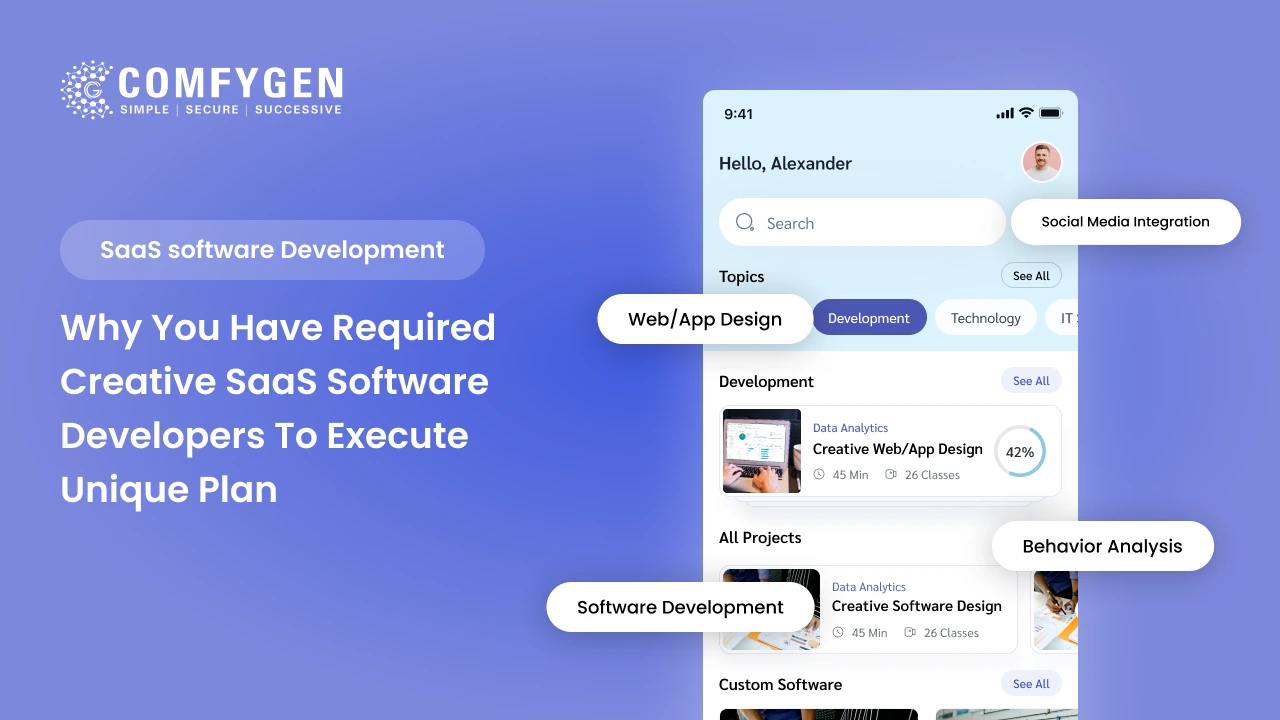
Why You Need Creative SaaS Software Developers for a Unique Project?
Businesses across industries are adapting Software-as-a-Service (SaaS) software solutions to streamline organization operations, improve customer experiences, and gain a competitive edge. However,…

